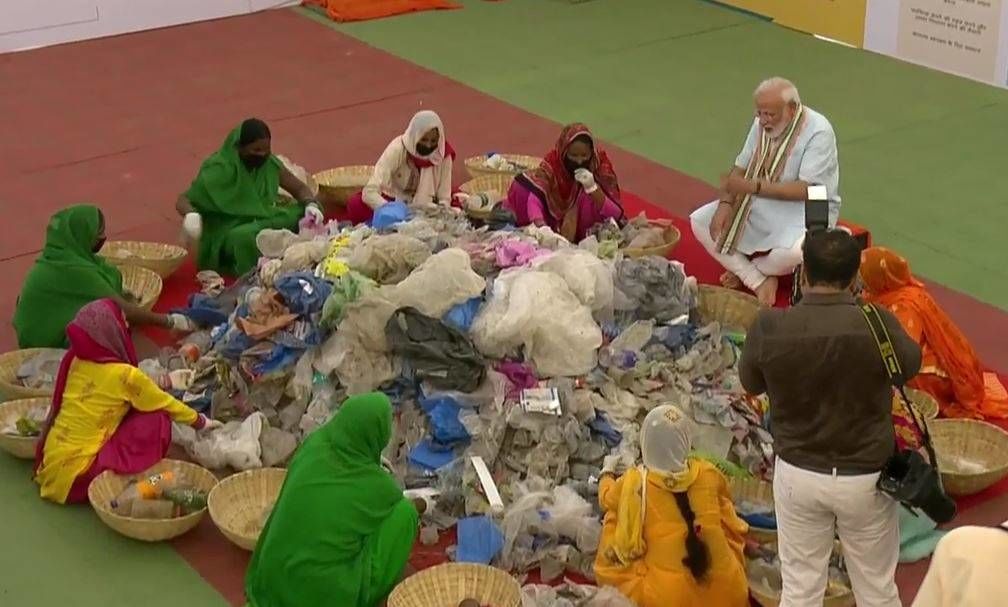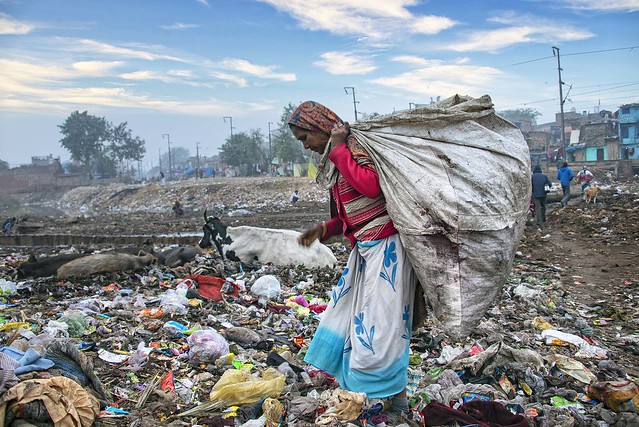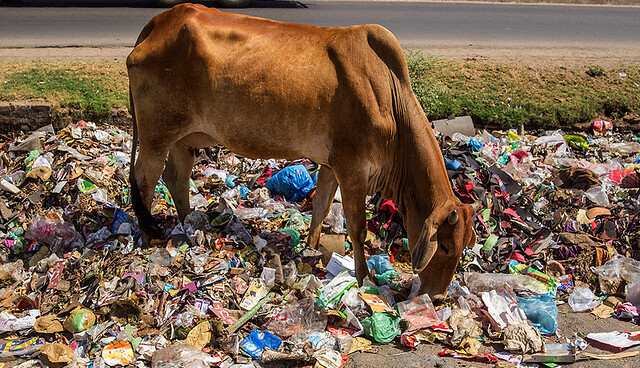The Pandemic and Pollution: Handling the packaging waste of increased online shopping
India witnessed a 250 per cent spike in non-organic shopping app installs. Most packaging is multi-layered, and stays out of the recycling process. The need of the hour is stricter legislation, say experts.


After moving from Bengaluru, Karnataka, to her hometown in Lucknow, Uttar Pradesh, right before the first novel coronavirus disease (COVID-19)-induced lockdown, 23-year-old Shubhi Agarwal has started buying groceries online. With corona cases still rising, visiting markets and shopping complexes remains unsafe. So, she prefers ordering things online, be it a bottle of shampoo or a kilogramme of wheat flour.
Once the delivery arrives, she sanitises the carton, removes the bubble wrap and empties out the individual packets into containers. After she is done unpacking, there’s a heap of plastic packaging inside the carton, which leaves her feeling guilty. Like thousands of other Indians, Agarwal has changed the way she shops to protect herself during the pandemic, but is struggling to make sense of all that plastic waste generated.
When you order clothes, medicine or grocery online, what else do you get on the side? A whole lot of plastic wrap, thermocol sheets, cardboard boxes, bubble wrapping sheets… the list of packaging waste is endless. The Narendra Modi-led Indian government aims to phase-out single-use plastic by 2022. But, in the COVID-19 pandemic, does one now focus on oneself or the environment?

According to the State of Shopping App Marketing 2020’s mobile marketing analytics, India witnessed a 250 per cent spike in non-organic shopping app installs as the country began lifting lockdown restrictions in May. This shows that e-commerce, or online shopping, has increased. And so has packaging waste. But, do the existing plastic management rules in the country have enough teeth to ensure compliance regarding disposal?
“As of now, we don’t have any packaging waste law in the country. Plastic management rules do not cover packaging; they cover plastics such as carry bags,” Ravi Agarwal, founder of New Delhi-based Toxics Link, an environmental non-profit, told Gaon Connection.
This plastic crisis is not new to us. Plastindia Foundation — India’s leading plastic industry body — has estimated an annual consumption of 16.5 million tonnes, of which almost half is plastic manufactured for single-use packaging material that immediately becomes a waste. This non-biodegradable waste breaks down into smaller fragments and contaminates soil and water, leading to severe health problems and harming marine life. When burnt, it leads to high air pollution and is linked with emission of cancer-causing pollutants.
“Burning waste is the worst one could do. By doing so, plastic gets into the human body through air and water. Such plastics contain complex chemicals, which are life-threatening,” said Ravi Agarwal.

Quantum of packaging waste
According to conservative estimates of the Central Pollution Control Board (CPCB), 60 major cities in the country generate around 25,940 tonnes of plastic waste every day. Of this, around 60 per cent is collected and recycled, mainly by the informal sector of waste pickers, while the rest ends up in landfills.
“You will find wrappers that once held snacks and thermocol bits used for safe packing floating in water bodies. These are single-use low value plastics that cannot be recycled. Such waste is immediate and is dumped,” Dharmesh Shah, Kerala-based plastic policy analyst, told Gaon Connection.
India’s segregation and recycling system operates through an informal chain of workers — waste pickers. “Around sixty to seventy per cent of the waste, especially dry waste that can be sold, is collected by waste pickers. They don’t pick wrappers and thermocol as these have no recycling value,” Ranjesh Kumar Singh, who works for the rights of waste pickers in Lucknow told Gaon Connection.
Waste collection, which is largely dependent on the informal sector, was affected by the COVID-19 pandemic too as waste pickers were not able to operate like they used to earlier.

Most of the informal sector was impacted as they were not allowed to pick waste on the roads and streets. Many went back to their native places. “When the value chain is affected, the entire informal workforce, from waste pickers and kabadiwalas to private bodies involved in recycling is also hit; hardly 50-60 per cent of this chain is operational as of now,” Swati Singh Sambyal, a waste management expert based in Delhi told Gaon Connection.
Sambyal believes the non-operational informal workforce has added to the woes of the country’s waste collection methods at the time when households have observed a rise in plastic packaging waste.
Much of the recycling chain is informal. They don’t have the bandwidth and capacity to segregate and recycle MLPs (multilayered plastics). “Segregation of waste is a major problem today. As of now, the waste is neither collected in a segregated manner nor transported or disposed of that way. It is high time agencies also worked towards reducing packaging waste,” she added.

Plethora of plastic waste rules
In 2017, when India’s plastic consumption rose from 8.5 million tonnes a year to 17.8 million tonnes a year, the inefficacy of the Plastic Waste (Management & Handling) Rules, 2011, became clear. A new set of plastic waste management rules were notified in March 2016 to supersede the 2011 rules.
The 2016 rules were hailed as progressive because of the emphasis on the responsibility of manufacturers and brand owners, commonly known as extended producer responsibility. According to Clause 9(3) of the rules, “manufacture and use of non- recyclable multi-layered plastic if any should be phased out in two years”.
The rules were again amended in 2018. This was the result of intense and effective lobbying by the plastic industry. The following observations on clause 9(3) of the 2016 rules were made by the committee — “Only non-recyclable and non-energy recoverable plastic should be banned. However, practically there is no plastic which is not recyclable or non-energy recoverable. Therefore, there is no need to ban Multi-Layered Plastics. The committee was of the view that we should remove the Rule regarding banning of MLPs from the PW Rules. MLPs waste should be regulated and its use in WE plants, cement plants etc be promoted.”

Waste management experts were slightly baffled. “The 2016 Rules banned the use of pouches and asked for a phase-out of multi-layered packaging that cannot be recycled. But the 2018 amendment diluted this by replacing the provisions and weakening them to say that if any of this is non-recyclable or non-energy recoverable or with no alternative use, it should be phased out within two years,” Sambyal said.
However, the end-use of non-incinerable/non-recoverable multilayered plastics is not clear, and, hence, the products continue to be used.
Talking Trash, a recent report from The Changing Markets Foundation, which works with nonprofits and research organisations to shift market share towards environmentally and socially beneficial solutions, revealed how companies use voluntary initiatives to appear to be part of the solution for the plastic crisis, while, at the same time, use trade associations, producer responsibility organisations and even fake environmental groups to aggressively oppose and lobby to delay progressive legislation to tackle the plastic crisis.
“Companies such as Pepsico and Nestle have developed voluntary mechanisms. They claim they are doing enough to manage the waste they generate. Every time the government tries to make laws, companies argue they will take care of plastic waste, and their plastic waste production should not be restricted,” said Shah.
The government says as long as companies can recover waste they produce, there is no harm. “The idea behind the law to save the environment from plastic is toothless now,” opined Shah. “Each company that generates plastic waste has to come up with a plan for waste collection and report to the government. So far, no company has done that. They prolong it and procrastinate,” he added.
According to Dipankar Saha, former additional director at Central Pollution Control Board, “Nothing is, by itself, waste. Disposal is the issue. Plastic is user-friendly, but needs to be made disposal-friendly as well. Everything can be recycled, even multi-layered plastic and thermocol. Such waste could be used in thermal power plants; they emit huge energy.”
But, multilayered packaging is non-recyclable, claimed experts. Contrary to what Saha said, Ravi Agarwal felt incineration or burning plastic was not the right method to deal with packaging waste. “Incineration is not recycling. It causes a lot of environmental damage,” he said.

A new packaging waste law?
As per the Plastic Waste Management Rules, 2016 and Amendments 2018, extended producer responsibility (EPR) mandates Producer Importers and Brand Owners (PIBOs) to collect, transport and scientifically dispose of the plastic that they introduce in the market.
“When you buy something, you don’t choose the packaging. Still, consumers are blamed. Producers have been blaming consumers for the last fifty years. If a company produces and then has to collect that waste, it will be careful about its production,” said Ravi Agarwal. However, there is no mandate to curb this. “Many parts of the world have it. All of Europe has it,” he added.
Pradnya Talekar, a lawyer based in Aurangabad, Maharashtra said the rules regarding disposal of plastic waste were all right, but the issue was executing them in letter and spirit. “If you abide by the rules strictly, ninety-eight per cent of the problem would get solved easily. The law says if a used milk pouch is found anywhere, the government will not hold the consumer responsible, but the brand,” Talekar told Gaon Connection.
Waste management expert Sambyal is of a similar opinion. She felt there’s no dearth of waste related legislations in the country, and a new one will only add to the complexity of the system.
Shah, who has been observing waste generation/disposal patterns of brands and wrote “Why India can’t beat the plastics crisis without the cooperation of corporations” analysed that Amazon has done a decent job in curbing the packaging waste it produces. “Amazon has partially shifted to cardboard packaging and uses paper glue tape in some of its packaging,” he said. “However, it needs to be strict about usage of thermocol by a few sellers,” he added.
Packaging waste aside, the COVID-19 pandemic has also led to an increased generation of medical waste, including personal protective equipment (PPE) waste. It becomes vital for both the government and manufacturers/brands to come up with ‘green’ solutions.
In a post-COVID-19 world, packaging waste is set to multiply manifold. The only way to tackle this is effective, strict legislation. Only time will tell that becomes a reality.

